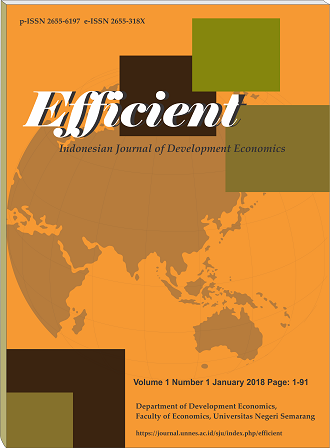Determinants of Poverty Rates in Papua Province in 2011 - 2019
Abstract
Indonesia is one of the countries with a high poverty rate. Throughout 2011 to 2019 Papua Province always occupied the province with the highest poverty rate in Indonesia. This study aims to identify the factors that influence the level of poverty in Papua Province. The independent variables in this study include economic growth, balancing funds, capital expenditures, life expectancy, and the average length of schooling. The type of data used is secondary data. The data collection technique used is literature study. The analysis method used is panel data regression analysis method using the Random Effect Model (REM). Furthermore, to overcome the problem of classical assumption testing is done using the WLS (Weighted Least Square) method on the GLS (Generalized Least Square). The results of this study indicate that economic growth has a positive but not significant effect on poverty levels. The balancing fund has a negative and significant effect on the poverty level. Capital expenditures and life expectancy also have a positive but not significant effect on the poverty level. Meanwhile, the average length of schooling has a negative and significant effect on the poverty level.
Indonesia merupakan salah satu negara dengan tingkat kemiskinan yang tinggi. Sepanjang tahun 2011 hingga 2019 Provinsi Papua selalu menduduki provinsi dengan angka kemiskinan tertinggi di Indonesia. Penelitian ini bertujuan untuk mengidentifikasi faktor-faktor yang mempengaruhi tingkat kemiskinan di Provinsi Papua. Variabel bebas dalam penelitian ini meliputi pertumbuhan ekonomi, dana perimbangan, belanja modal, angka harapan hidup, dan rata-rata lama sekolah. Jenis data yang digunakan adalah data sekunder. Teknik pengumpulan data yang digunakan adalah studi kepustakaan. Metode analisis yang digunakan adalah metode analisis regresi data panel dengan menggunakan Random Effect Model (REM) dan metode WLS (Weighted Least Square) pada GLS (Generalized Least Square). Hasil penelitian ini menunjukkan bahwa pertumbuhan ekonomi berpengaruh positif namun tidak signifikan terhadap tingkat kemiskinan. Dana perimbangan berpengaruh negatif dan signifikan terhadap tingkat kemiskinan. Pengeluaran modal dan harapan hidup juga berpengaruh positif namun tidak signifikan terhadap tingkat kemiskinan. Sedangkan rata-rata lama sekolah berpengaruh negatif dan signifikan terhadap tingkat kemiskinan.






